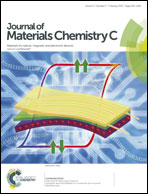Intramolecular charge transfer (ICT) of a chiroptically active conjugated polymer showing green colour
Abstract
A donor–acceptor type achiral monomer 4,7-bis(2,3-dihydrothieno[3,4-b]-1,4-dioxin-5-yl)-2,1,3-benzothiadiazole was synthesised and electrochemically polymerised in a cholesteric liquid crystalline (CLC) medium. This film exhibits a fingerprint pattern under the polarised optical microscopic observation. A possible mechanism of the fingerprint structure formation through a procedure of electrochemical polymerisation in a CLC medium is presented. The preparation of chiral polymer films even from achiral monomers is demonstrated. The film shows green colour in the reduced state and blue in the oxidised state. Changes in colour and CD signals of the film are repeatable with electrochemical oxidation and reduction. The presence of radical cations in the chiral environment, referred to as chiralions, distributed along chiral polymer chains is proposed.


 Please wait while we load your content...
Please wait while we load your content...